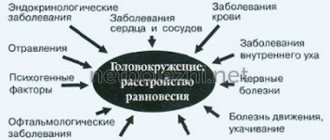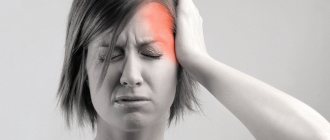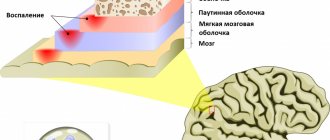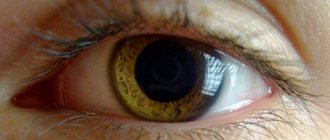Definition and Features
It is necessary to distinguish between true dizziness, in which there is a feeling of objects moving in space. Such symptoms may be normal if they occur after prolonged rotation around its axis (on a carousel), but in other cases they indicate a malfunction of the vestibular apparatus. The difficulty in diagnosing this condition is that the doctor has to rely only on the patient’s testimony. Many people also mean other symptoms by this term: impaired visual acuity, headaches and others. In reality, dizziness should be understood as a feeling of movement of environmental objects in relation to a person, while the body position is felt as stable. Most often these are circular movements (objects rotate around a person’s axis), but they can also be linear (a feeling of falling or rising in height, various shocks).
Vestibular neuronitis
Vestibular neuronitis or neuritis means inflammation of the vestibular root of the 8th pair of cranial nerves, i.e., the vestibular-cochlear nerve. It has not yet been reliably determined what exactly provokes the development of this disease. According to research, it is assumed that herpes virus infection type 1 is involved in this. This theory is also supported by the fact that most often neuritis manifests itself after suffering from an acute respiratory infection.
The disease is characterized by a sudden onset of severe dizziness with a sensation of rotation of surrounding objects, which tends to gradually weaken over time. But head movements or changes in body position provoke a deterioration in health. The attack is accompanied by nausea, vomiting, and nystagmus. In this case, the oscillatory movements of the eyes are directed towards the healthy ear. There is also an imbalance, with falls more often occurring on the side of the healthy ear. But vestibular neuritis is not accompanied by hearing impairment or neurological disorders.
Dizziness may last for hours or days, and unsteadiness may persist for a week or longer.
When diagnosing vestibular neuronitis, symptomatic therapy is indicated to alleviate the patient’s well-being. It is designed to eliminate nausea, vomiting and reduce the severity of dizziness. Specific drugs are selected by a neurologist individually, taking into account the characteristics of the patient’s condition and the nature of concomitant diseases. As a rule, the course lasts no more than 3 days.
It is also recommended to perform special visual exercises, head movements, walking and balance exercises. They need to be performed daily, devoting at least half an hour to exercise.
In most cases, the measures taken are sufficient to eliminate the disease and normalize the patient’s condition. Within a few weeks, central vestibular compensation occurs, which leads to the elimination of the symptoms of neuritis. But instability and difficulty maintaining balance, especially when moving the head, can persist for a long time. But in 15% of patients, after the symptoms of vestibular neuronitis subside, the development of BPPV is observed, and psychogenic dizziness often occurs.
Anatomy and mechanism of development of pathology
With dizziness, there is a growing lack of coordination of movements and balance. To find out its cause, one must understand how the transmission of nerve impulses that play a role in proprioception occurs. This term refers to a person’s ability to identify and sense the position of parts of his own body relative to each other and objects in the environment. Information is perceived by proprioceptor organs, including muscle tissue, and then moves along peripheral nerves to the spinal cord, from where it enters the brain. The necessary picture is formed in the parietal lobe of the brain after nerve impulses pass through the thalamus.
The inner ear is an organ that is responsible for a person's ability to maintain balance. It has a complex structure and consists of several sections: the vestibule, 3 semicircular canals and the cochlea. The inner ear is protected by bone tissue that forms the temporal lobe of the skull. It is filled with aqueous fluid - it moves when a person tilts and turns his head, and this information is perceived by sensitive cells to identify the position of the body in space.
The nervous system collects information that comes from the visual apparatus, tactile receptors and other sensory organs, as well as from the inner ear, and then analyzes it. The center of balance is located in the cerebral cortex, namely in its temporal region. Along the nerves, impulses reach the vestibular nuclei - clusters of nerve cells capable of perceiving, analyzing and coordinating information received from different areas.
Dizziness is a disturbance in the sense of balance. Anatomically, it can occur at several levels:
- peripheral - in case of disturbance of impulse conduction at the level of the vestibular nerve or inner ear (organ of balance);
- intermediate - the pathological process is localized at the stage of transmitting information from the inner ear to the central nervous system;
- central - associated with diseases of the brain, in which it is unable to analyze the information received.
Clinical signs of dizziness of different origins do not differ. The patient experiences a feeling of disorientation in space and abnormal movement of environmental objects. However, short-term loss of balance cannot be a consequence of serious diseases of the cerebral cortex. Such dizziness is accompanied by a number of additional symptoms and occurs after injury or certain diseases. To diagnose the cause and mechanism of development of this symptom, doctors at the Clinical Institute of the Brain carry out a comprehensive examination to determine accompanying symptoms.
Bilateral vestibulopathy
Bilateral vestibulopathy refers to bilateral deficits in vestibular function, which is clinically manifested by:
- attacks of dizziness while moving with the illusion of rotation of the environment;
- instability;
- imbalances, especially severe in the dark and when walking on uneven surfaces;
- decreased visual acuity while walking and making head movements.
But all the symptoms are observed only when the person is in an upright position. If he sits or lies, there are no such violations.
Most often, bilateral vestibulopathy occurs as a result of taking medications, especially aminoglycoside antibiotics, as well as after suffering from infectious and inflammatory diseases of the brain and some other pathologies.
It is impossible to completely eliminate the disorder, but by performing a special set of exercises selected separately for each patient, it is possible to achieve the development of central vestibular compensation.
Forms of dizziness
To more accurately determine the cause of dizziness, there are several classifications of this symptom. This distribution is necessary to understand the danger of the disease and to prescribe an effective treatment regimen. Various types of therapy can be carried out by doctors of different specialties. Thus, the first classification distinguishes two types of dizziness: systemic and non-systemic.
- Systemic dizziness is a more dangerous type, which in any case indicates pathology. It is associated with a violation of nerve conduction at the level of the vestibular apparatus (inner ear, vestibular nerve, parts of the cerebral cortex). Systemic dizziness can be central, intermediate or peripheral, depending on the location of the pathological process.
- Non-systemic dizziness is also called physiological. It manifests itself in the absence of pathological changes in the vestibular apparatus, but may be a consequence of its excessive irritation. Thus, non-systemic dizziness is one of the clinical signs of motion sickness syndrome, and also occurs after a long and monotonous rotation around its axis.
Symptoms of dizziness may vary. In this regard, it is also customary to distinguish several of its varieties:
- tactile - the patient experiences a sensation of loss of support under his feet, instability, as on a ship;
- proprioceptive - associated with a change in the identification of the body in space, with a feeling that the body is rotating around an axis, and the surrounding objects remain in their places;
- visual - visually the human body remains motionless, and the environment begins to move in different projections.
It is worth understanding that systemic dizziness manifests itself in a more vivid clinical picture. It is associated with damage to neural connections, so symptoms appear and remain even without an apparent reason. In addition, loss of balance is accompanied by other characteristic manifestations of damage to the nervous system or analyzer systems. Non-systemic dizziness is temporary and can go away spontaneously as soon as the vestibular system adapts to environmental changes. The second case does not pose a danger to humans.
Etiology and pathogenesis of dizziness
Providing balance is possible by integrating the activities of the vestibular, proprioceptive, visual and tactile systems, which are closely connected with the cerebral cortex and subcortical formations. Histamine, which acts on histamine receptors, plays a critical role in the transmission of information from the receptors of the semicircular canals. Cholinergic transmission has a modulating effect on histaminergic neurotransmission. Thanks to acetylcholine, it is possible to transmit information from receptors to the lateral vestibular nuclei and the central parts of the vestibular analyzer. It has been proven that vestibulovegetative reflexes function due to the interaction of cholinergic and histaminergic systems, and histamine and glutamatergic pathways provide vestibular afferentation to the medial nucleus.
Main causes of the symptom
Dizziness can be a symptom of a number of diseases and pathological conditions that lead to disruption of the vestibular apparatus. These are congenital or acquired disorders of varying severity, with different mechanisms of development and characteristics of clinical manifestations. Among the most common groups of causes of this symptom are the following:
- inflammatory diseases of the inner ear and vestibular nerve - can be of infectious or non-infectious origin;
- intoxication and poisoning, which lead to disruption of the vestibular apparatus;
- traumatic brain injuries - when certain areas of the cerebral cortex are damaged, dizziness may appear after a long time;
- metabolic disorders, including diabetes.
Impaired balance and coordination of movements in space can also be a variant of the norm. In some cases, intense irritation of the vestibular apparatus occurs (on a carousel, during a long stay on a ship or on another unstable support), after which the nervous system needs time to recover. It is impossible to determine the cause of dizziness at home, especially if it is a consequence of organic lesions of the central nervous system.
Main types of illness
A healthy person may become dizzy when exposed to a strong external irritant. Malaise can occur while skating or a carousel, while the human body cannot independently control the force of rotation. Dizziness can be divided into the following forms:
- Vestibular (otherwise known as vertigo). This form of dizziness is called true, in this case a person feels the movement of all objects that are near him, in some cases you can feel the movement of your body.
- Collaptoid. Occurs when there is a sudden change in body position or pressure that is applied to the head. At this moment, a person has a desire to take a horizontal pose as soon as possible.
- Age. Occurs in older people due to imbalance. In this case the symptom is not true.
- Conditions that are often confused with dizziness (severe fatigue, stress, neurological problems, etc.). In this case, the patient begins to complain of characteristic pain in the heart and fear of dizziness.
Clinical picture of different types of dizziness
The main clinical manifestation of dizziness is a feeling of loss of balance and imaginary movement of the body in space. However, this symptom may indicate a number of different disorders, the symptoms of which will differ. At the Clinical Brain Institute, you can undergo a full examination using laboratory and instrumental techniques that will allow you to detect all possible diseases that cause dizziness. However, even an initial examination and medical history will clarify the picture and make a preliminary diagnosis. Systemic dizziness, as a manifestation of functional disorders of the vestibular apparatus, should be considered separately from non-systemic dizziness, which does not pose a danger and can even be considered a variant of the norm.
Systemic dizziness
Systemic dizziness includes a number of diseases associated with various disorders of the conduction of nerve impulses to the cerebral cortex. The pathological process can be located at any level, and therefore the symptoms will differ. Thus, each pathology that may underlie the mechanism of development of dizziness should be considered separately. Systemic types occur in no more than a third of patients and require more detailed examination.
- Benign paroxysmal positional vertigo (BPPV) is the main cause of systemic varieties. The process is associated with the formation and deposition of crystals of calcium carbonate salts on the tissues of the semicircular canals of the inner ear. This is an acquired chronic disease, the leading clinical sign of which is short-term dizziness and loss of orientation in space. The attacks last no more than 1 minute, with no additional symptoms (headache, tinnitus).
- Inflammation of the vestibular nerve (vestibular neuronitis) is a dangerous condition that often develops against the background of a bacterial or viral infection. Its reproduction with damage to the nervous system causes a characteristic set of symptoms, which includes dizziness. The duration of their manifestation ranges from several hours to several days, and their intensity remains high or even intensifies. Hearing is preserved in vetibular neuritis.
- Post-traumatic dizziness is complete or partial disorientation that develops immediately after a traumatic brain injury. The process is associated with damage to areas of the cerebral cortex responsible for transmitting information about the position of the human body in space. Clinical signs may vary in intensity and persist until the tissue has completely healed, and in some cases they appear several days after the injury.
- Intoxication is another cause of dysfunction of the vestibular apparatus. Toxins, including aminoglycosides, can accumulate in peri- and endolymph, the fluid that fills the structures of the inner ear.
- Meniere's disease is a disease in which there is an increase in the amount of endolymph (hydrops). The fluid is located in the lumen of the labyrinth of the inner ear, and an increase in its volume leads to excess pressure on its walls. The disease occurs in attacks, the interval between which can range from several days to several months. The duration of one attack is from several hours to a day, and the symptoms are very pronounced. The patient experiences acute disorientation in space, dizziness and headaches. The disease progresses and causes gradual deterioration of hearing (usually a unilateral phenomenon), but complete loss does not occur.
- Temporal lobe epilepsy is a pathological condition that is manifested by a periodically manifested complex of autonomic disorders (dizziness, headache, low blood pressure, and others). The patient's condition deteriorates suddenly, for no apparent reason, and the attack may be accompanied by deterioration of vision.
- Lipotymic conditions are a set of symptoms that precede fainting. The patient experiences severe dizziness, weakness, his skin and mucous membranes turn pale, and his heartbeat becomes less frequent. An attack can occur for many reasons, including diseases of the cardiovascular system, a decrease in blood glucose concentration, an increase or decrease in blood pressure.
Systemic dizziness most often occurs in old age, but can also occur in young people. The development of the disease should be monitored over time, taking into account the frequency and intensity of attacks. It is also important to monitor the occurrence of additional signs: hearing and vision impairment, fainting, nausea, migraines. These data will make it possible to determine the severity of violations even before specific analyzes are carried out.
Non-system varieties
One of the most characteristic signs of non-systemic dizziness is that its clinical manifestations intensify if you close your eyes. The causes of this condition may be various dysfunctions of the cerebellum and other structures that regulate motor activity and coordination of movements. Additional clinical signs include general weakness and drowsiness, decreased visual acuity, deterioration of memory and attention. Similar symptoms may occur with systemic use of certain groups of drugs (benzodiazepines). The patient's condition in such cases improves by adjusting the dosage of medications.
Providing assistance at home
If dizziness bothers you regularly, you need to contact a neurologist who will find out the cause of the problem and help eliminate it. Before visiting a doctor, you can try to get rid of dizziness during sleep using several traditional medicine methods. These include:
- light massage of the neck and scalp;
- performing regular breathing exercises for two minutes (to do this, place a hand on your stomach and begin breathing slowly through your mouth, while you need to inflate your stomach as much as possible when you inhale and draw it in when you exhale);
- pressing the center of the forehead with your fingertips for several seconds (about ten);
- ventilation of the apartment;
- getting rid of tight clothes (they should be unbuttoned or removed);
- Avoid sudden body movements, including sudden turns of the head. You need to take a vertical position carefully, without rushing.
Changing your lifestyle can significantly improve the patient’s condition and even cure dizziness. That is why experts advise normalizing your diet, following a daily routine (it is very important to distinguish between rest and sleep time), taking active walks in the fresh air for at least an hour every day, and conducting therapeutic exercises.
These measures have a therapeutic effect for any pathologies that provoke dizziness. Their regular adherence will help a person prevent the progression of the disease and reduce the symptoms of vertigo.
If, despite following all the advice of a specialist, the head continues to feel dizzy, leading to further deterioration of the patient’s condition, it is necessary to immediately call an ambulance.
Diagnostic methods
The Clinical Brain Institute has all the conditions for a full diagnosis of dizziness. The process is carried out by analyzing the work of the vestibular apparatus and the brain, after which the localization of the pathological process and its stage can be detected. During the initial examination, it is important to conduct a detailed interview with the patient and obtain a detailed description of the complaints. At this stage, it is possible to differentiate true dizziness from other conditions that are also often called by this term. Next, specialists will select an individual diagnostic scheme, which may include the following steps:
- examination of the spinal column (analysis of X-rays, CT or MRI) to identify osteochondrosis, vertebral displacements and other pathologies that cause impaired blood supply to parts of the brain;
- examination by a neurologist, which includes determination of nystagmus, various tests and assessment of the ability to coordinate movements;
- examination of the state of the brain using MRI or CT - carried out to exclude tumors and other diseases leading to demyelination of nerve fibers;
- electroencephalography is a way of assessing brain activity by capturing the signals it produces;
- study of the functioning of the vestibular apparatus - may include rotational tests, vestibulometry and other tests.
Instrumental techniques are prescribed after a general examination. Based on the data obtained, the doctor can determine what examinations need to be performed in order to conduct a differential diagnosis and exclude possible causes of dizziness. Thus, if Meniere's disease is suspected, patients are offered a test to detect low-frequency sound signals.
Airsickness
Air sickness occurs when the vestibular system is disrupted. The pathology manifests itself in the form of dizziness, headache, muscle weakness, drowsiness, nausea, vomiting, drowsiness, and weakness. Patients may also notice blurred vision, changes in taste, dry mouth, and increased sweating.
A pathological process occurs when the brain receives conflicting signals. It turns out that, on the one hand, you are sitting still, but on the other, you are still moving. Visual analyzers see a changing picture, while your body remains in place.
Let's talk about effective tips that will help reduce the manifestations of air sickness:
- before planting, do not eat much;
- try not to set yourself up negatively;
- before the flight, drink Bonine or Dramamine;
- try acupressure;
- do not make sudden movements, try to sit in the chair for as long as possible;
- You should not read on the plane, it will only worsen the symptoms of air sickness;
- places near the wing are considered the most stable and there is less shaking;
- Chew mint gum.
Flying on an airplane can cause dizziness, nausea and weakness
Treatment and prognosis
Specialists at the Clinical Brain Institute will select the most effective treatment regimen, depending on the diagnostic results. In most cases, dizziness does not pose a threat to the life and health of the patient and is easily corrected with general measures and medication. Thus, the following methods of treating the causes and clinical signs of this condition may be recommended:
- constant monitoring of blood pressure indicators, if necessary, taking antihypertensive drugs;
- preventing the appearance of edema - limiting salt intake, prescribing diuretics (diuretics);
- taking vestibulics - drugs to eliminate the symptoms of dizziness;
- if necessary - antihistamines, anti-epileptic drugs;
- restoration of movement coordination with special exercises.
Dizziness is not a disease, but one of the symptoms of a dysfunction of the vestibular apparatus. It is impossible to determine its cause at home, so if it occurs, it is worth undergoing a comprehensive diagnosis at the Clinical Brain Institute. It employs broad and specialized specialists who regularly examine and treat patients with similar symptoms. The medical center also has the opportunity to undergo complex examinations using high-quality equipment necessary to make a diagnosis. Despite the fact that dizziness alone is not a dangerous symptom and cannot threaten the patient’s life, it can indicate serious problems with the vestibular system and organic lesions of the central nervous system in the early stages. It is impossible to cure these pathologies on your own, but an integrated and competent approach in a hospital setting will eliminate both the causes and manifestations of dizziness.
Migraine
Compared to migraines in women, attacks in men are rare, but they are quite painful. First, let's talk about the causes of the disease. Experts say that nutritional, psychogenic, emotional and physical factors can influence the development of the disease. An attack can be triggered by excessive consumption of foods containing large amounts of sugar.
Products containing caffeine can also cause pain. As for psychogenic factors, migraines can be caused by stress, excess emotions, and lack of sleep. Bright light, a strong smell, a change in living conditions - all this can also trigger a severe headache attack.
Headaches can bother men for a long period of time. During an attack, the patient feels depressed and overwhelmed. There is a decrease in concentration, and sometimes memory lapses may even occur. Migraine causes nausea, vomiting, pain in certain areas of the head, and increased body temperature.
Drug therapy is aimed at relieving symptoms, primarily pain. Cold compresses and headbands can also help relieve severe pain. A warm bath and a heating pad placed on your feet will help you relax. As soon as you notice that a migraine attack is starting, it is better for you to go to a quiet and calm room with dim lights.
During a migraine attack, men experience headaches, dizziness, weakness, and nausea
Popular medications on the topic
Cerebrolysin Cerebrolysate
For more information about the causes of dizziness, watch the video:
Diagnosis and treatment of dizziness is a difficult task even for an experienced doctor. In every case of a painful, prolonged or sudden attack, consultation with a specialist is required. Only he will determine what the patient should do next, what consultations and examinations she needs.
This article has been verified by a current qualified physician, Victoria Druzhikina, and can be considered a reliable source of information for site users.
Bibliography
1. https://kiberis.ru/?p=50203 2. https://nikio.ru/docs/02-golovokruzhenie1.pdf 3. https://docs.cntd.ru/document/901918942
Assess how much it was useful article
4.4 139 people voted, average rating 4.4
Did you like the article? Save it to your wall so you don’t lose it!











